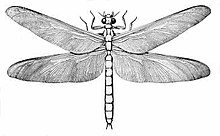മെഗാനിസൊപ്റ്റെറ
ഒഡോനെറ്റോപ്റ്റെറ എന്ന അതിനിരയിൽ ഉൾപ്പെട്ട വംശനാശം സംഭവിച്ച വലിയ പ്രാണികളുടെ ഒരു നിരയാണ് മെഗാനിസൊപ്റ്റെറ (Meganisoptera). ഇന്നത്തെ തുമ്പികളുമായുള്ള അവയുടെ സാമ്യം മൂലം അവയ്ക്ക് ആദ്യം പ്രോട്ടോഡനേറ്റ (Protodonata) എന്നാണ് പേരു നൽകിയത്. പാലിയോസോയിക് യുഗത്തിലെ കാർബോണിഫെറസ് കാലഘട്ടം മുതൽ പേർമിയൻ കാലഘട്ടം വരെയാണ് ഇവ ഭൂമിയിൽ ജീവിച്ചിരുന്നത്. ഇവയിൽ പലതിനും ഇന്നത്തെ തുമ്പികളേക്കാൾ കുറച്ചുമാത്രം വലിപ്പക്കൂടുതലെ ഉണ്ടായിരുന്നൂവെങ്കിലും വളരെ വലിയ Meganeura monyi (68 സെന്റിമീറ്റർ (27 ഇഞ്ച്)),[1] Megatypus, Meganeuropsis permiana (71 സെന്റിമീറ്റർ (28 ഇഞ്ച്)) പോലെയുള്ളവയും അക്കൂട്ടത്തിൽ ഉണ്ടായിരുന്നു.[2][3][4]
| മെഗാനിസൊപ്റ്റെറ | |
|---|---|

| |
| Meganeura | |
| ശാസ്ത്രീയ വർഗ്ഗീകരണം | |
| Domain: | Eukaryota |
| കിങ്ഡം: | Animalia |
| Phylum: | ആർത്രോപോഡ |
| Class: | പ്രാണി |
| Superorder: | Odonatoptera |
| Order: | †Meganisoptera Martynov, 1932 |
| Families | |
| Synonyms | |
| |

ഇവയ്ക്ക് തുമ്പികളുടേതുപോലുള്ള പിൻചിറകുകളുടെ ഘടന, നോഡ്, റ്റെറോസ്റ്റിഗ്മ എന്നിവ ഉണ്ടായിരുന്നില്ല. പലതിന്റെയും ചിറകുകളുടെ ഭാഗങ്ങളോ ചിലപ്പോൾ അടയാളങ്ങളോ മാത്രമേ ലഭിച്ചിട്ടുള്ളൂ. ഉരുണ്ട തലയും വലിയ ചവയ്ക്കാനുള്ള ചുണ്ടുകളും ബലമുള്ളതും മുള്ളുകൾ ഉള്ളവയുമായ കാലുകളും വലിയ ഉരസും നീണ്ടു മെലിഞ്ഞ ഉദരവും അവയ്ക്കുണ്ടായിരുന്നു. തുമ്പികളെപ്പോലെതന്നെ അവരും മികച്ച വേട്ടക്കാർ ആയിരുന്നിരിക്കാം.
വളരെക്കുറച്ചു ലാർവകളും കണ്ടെത്തിയിട്ടുണ്ട്. തുമ്പികളെപ്പോലെതന്നെ അവയും ജലജീവികൾ ആയിരുന്നു.[5]
അവലംബം
തിരുത്തുക- ↑ The Biology of Dragonflies. CUP Archive. p. 324. GGKEY:0Z7A1R071DD.
No Dragonfly at present existing can compare with the immense Meganeura monyi of the Upper Carboniferous, whose expanse of wing was somewhere about twenty-seven inches.
- ↑ Grimaldi & Engel 2005 p.175
- ↑ G. Bechly, C. Brauckmann, W. Zessin, E. Gröning (2001): New results concerning the morphology of the most ancient dragoflies (Insecta: Odonatoptera) from the Namurian of Hagen-Vorhalle (Germany). Journal of Zoological Systematics and Evolutionary Research 39: S. 209–226.
- ↑ E. A. Iarzembowski, A. Nel (2002): The earliest damselfly-like insect and the origin of modern dragonflies (Insecta: Odonatoptera: Protozygoptera). Proceedings of the Geologists' Association 113: 165–169.
- ↑ Hoell, H.V., Doyen, J.T. & Purcell, A.H. (1998). Introduction to Insect Biology and Diversity, 2nd ed. Oxford University Press. p. 321. ISBN 0-19-510033-6.
{{cite book}}: CS1 maint: multiple names: authors list (link)
- Carpenter, F. M. 1992. Superclass Hexapoda. Volume 3 of Part R, Arthropoda 4; Treatise on Invertebrate Paleontology, Boulder, Colorado, Geological Society of America.
- Grimaldi, David and Engel, Michael S. (2005-05-16). Evolution of the Insects. Cambridge University Press. ISBN 0-521-82149-5.
{{cite book}}: CS1 maint: multiple names: authors list (link) - Tasch, Paul, 1973, 1980 Paleobiology of the Invertebrates, John Wiley and Sons, p. 617
- André Nel, Günther Fleck, Romain Garrouste, Georges Gand, Jean Lapeyrie, Seth M Bybee, and Jakub Prokop (2009): Revision of Permo-Carboniferous griffenflies (Insecta: Odonatoptera: Meganisoptera) based upon new species and redescription of selected poorly known taxa from Eurasia. Palaeontographica Abteilung A, 289(4-6): 89–121.